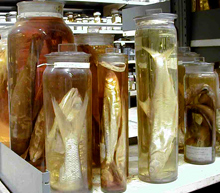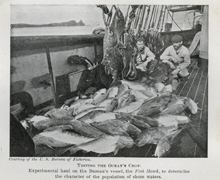The Fish Collection at the Smithsonian Institution's National Museum of Natural History
Established in 1856 by Spencer Fullerton Baird

Spencer Fullerton Baird, appointed by President Grant as the first U.S. Fish Commissioner in 1871, established the fish collection in 1856 when affiliated with the Smithsonian. Baird appealed to expedition naturalists of the era to help build the collection. Click image for larger view.
The origin and development of the Fish Collection at the National Museum of Natural History follows closely the career of Spencer Fullerton Baird, the rise of NOAA's National Marine Fisheries Service and its ancestor organizations–the U.S. Commission of Fish and Fisheries (1871), U.S. Bureau of Fisheries (1903), and Bureau of Commercial Fisheries (1956)–and the Smithsonian Institution. Baird, the first U.S. Fish Commissioner, established the collection around 1856 when he was an assistant secretary at the Smithsonian, donating a sucker, Catostomus hudsonius, which he collected at Lake George, New York, in 1850. Baird urged colleagues to contribute their own collections in the spirit of public generosity. And, he appealed to expedition naturalists to acquire specimens for the collection as they sailed the world and traversed the North American continent.
Baird's appeals succeeded. Between 1838 and 1842, the U.S. Exploring Expedition, also known as the Wilkes Expedition, amassed an estimated forty tons of natural history specimens and cultural objects from this voyage that explored Antarctica, the South and Central Pacific Ocean, and the Oregon coast. In 1858, soon after beginning the Fish Collection, the museum received the Wilkes Expedition's materials. Today they are the foundation of the national collections held by the Smithsonian's various museums.
The World's Largest Fish Collection
With about four million specimens, the Fish Collection at the National Museum of Natural History in Washington, D.C., ranks, by far, as the world's largest in both quantity and diversity. Approximately 19,000 lots in the collection are important "type" specimens. (A lot contains all specimens of a species that were collected at the same time and place. "Type" specimens are the basis for taxonomic names and identifications.) Smithsonian curators and NOAA scientists continually add specimens to the collection.

The Smithsonian National Museum of Natural History houses four million specimens in the Fish Collection. Click image for larger view.
The collection contains representatives of about 20,000 of the 28,000 (about 71 percent) described valid species of fishes worldwide. The collection also holds approximately 20,000 original illustrations of fishes, at least half of which the Bureau of Commercial Fisheries transferred to the Smithsonian in 1962. Researchers and scholars from around the world use and contribute to this collection, which is international in scope. The collection is particularly strong on Indo-Pacific, South American, and North American freshwater and marine fishes. The museum makes about 400 loan transactions to other scientists annually.

Museum curators store most specimens in row after row of bottles containing 75 percent ethyl alcohol. Click image for larger view.
Curators store most of the specimens in row after row of preservative-filled bottles, organized from the most primitive to the most advanced fish species. Some specimens have been dissected, and their skeletal remains are stored in boxes. The collection resides away from public viewing areas of the museum. But persons wishing to view or study the collection can arrange for access or special tours. The largest specimens are tunas and marlins up to seven feet long. The smallest are larval fishes reaching barely two millimeters.
Specimens from Historic Expeditions

Experimental hauls on the fisheries research steamer Fish Hawk helped to determine the character of inshore fish populations. The vessel, which sailed from 1880 to 1926, also contributed significantly to the national fish collection. Click image for larger view.
The Wilkes Expedition materials also supplied the specimens for the original research collection of fishes at the Smithsonian. Donations from private collections and from the great surveying expeditions of the 1850s–the U.S. and Mexican Boundary Survey, the Pacific Railroad Surveys, the Northwest Boundary Survey, and the North Pacific Exploring Expedition–augmented this collection. Extensive U.S. trawling expeditions sponsored by the Bureau of Fisheries and conducted aboard the Blake, Albatross, Fish Hawk, and other ships in the late 1800s and early 1900s contributed many specimens. So did the famed ichthyologist (fish scientist) David Starr Jordan along with his students and colleagues from the 1860s to the 1920s.
Adding to the Collection
Establishing the U.S. Commission of Fish and Fisheries in 1871 benefited the collection and the development of fisheries science in the U.S. enormously. It became the collecting arm of the museum. The commission was a means for Baird to assemble researchers for the museum's fish division. It established field stations and acquired sea-going research vessels, which collected specimens in both U.S. waters and the world oceans. The commission supported a complete survey of the nation's fish and fishing industries as a project of the 1880 census. By the end of the 19th century, the collection had increased five-fold, to some 50,000 specimens.

NOAA's David Stein. a Research Associate in the Fish Division of the Smithsonian Institution, holds a large snailfish (Careproctus ovigerum) from the Fish Collection gathered around 1970 in deep water off Oregon's coast. Stein is one of five experts in the world on snailfish.
In 1942, the U.S. Fish and Wildlife Service added its fish collection to the museum's. Along with the specimens came two ichthyologists. This is generally accepted as the birth of the National Marine Fisheries Service National Systematics Laboratory, which is still located in the museum. Today, specialists at the this lab work on the taxonomy and classification of fishes, squids and octopods, crustaceans, sponges, jellyfishes, and corals of economic or ecological importance to the United States.
The Fish Collection at the National Museum of Natural History is of great historical and taxonomic importance to the nation. It is a storehouse and treasury of fishery science and a window to early expeditions and voyages of discovery. Thanks to the foresight, perseverance and hard work of Spencer Fullerton Baird and the U.S. Commission of Fish and Fisheries, NOAA, a direct descendant of that organization, helps to care for and make scientific use of the largest fish collection in the world.










